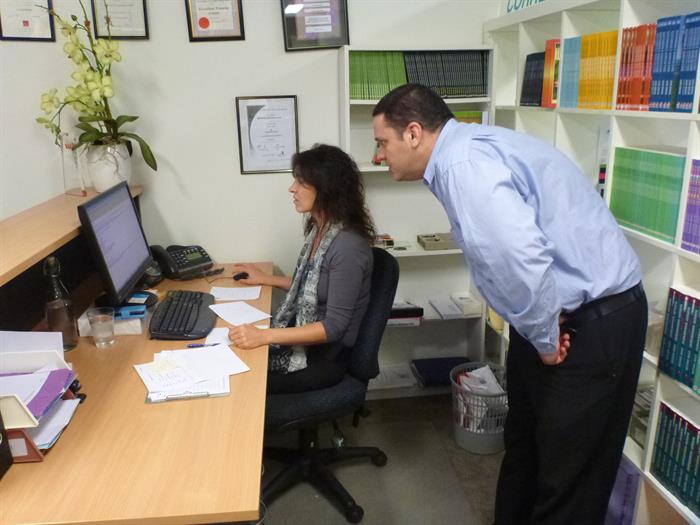HOME STUDY COURSE in INSTRUCTIONAL SKILLS
 Be a better trainer in the workplace
Be a better trainer in the workplace- Develop critical skills as a supervisor or manager
- Learn to Train Staff, Colleagues, Students, Clients
Course Duration: 100 hours
COURSE AIMS
- Analyse the communication effectiveness within a training environment.
- Explain characteristics which influence the effectiveness of education, including aspects of both learning and teaching.
- Define training requirements for a specified workplace.
- Prepare for commencement of a training session.
- Develop a lesson plan for training a small group (less than twelve).
- Develop skills in the assessment and evaluation of training programs.
- Demonstrate the use of audio-visual equipment for lesson presentation.
- Demonstrate the instruction of a learner in a one-to-one situations.
- Determine the use of simple motivational skills in a training environment.
- To promote training and monitor the result of promotion.
- Prepare trainees to meet the requirements of the competency standards for assessors.
COURSE STRUCTURE
There are 11 lessons with a written assignment to be submitted at the end of each lesson as follows:
1. Introduction to Training – Communication
2. Understanding Learning
3. Determining Training Requirements in The Workplace
4. Commencing Training
5. Developing a Lesson Plan
6. Assessment and Evaluation of Training Programs
7. Training Aids
8. One-To-One Training
9. Motivation Skills and Techniques
10. Promoting Training
11. Assessor Training
WHAT YOU WILL DO IN THIS COURSE
Here are some examples:
- Identify interactions that can occur between teacher and a learner, through a case study.
- Compare adult learning characteristics with child learning characteristics.
- Diagnose in 4 case studies, common barriers for learning, including;
-Class Disruptions -Concentration -Motivation -Fear of Complexity
- Investigate how different training programs are promoted through newspapers, magazines, brochures, handbooks, trade show displays, radio advertising etc.
- Consider the effectiveness of different promotions you discover.
- Describe an appropriate procedure for the notification of trainees of a forthcoming (hypothetical) training session. This training session can be on a topic selected by you Identify eight different methods which may be used for promoting training courses for a training provider who you are familiar with. These may be methods which are already being used, or they may be methods which you think may be worth trying.
- Collect information on assessment procedures.
* Look at assessment procedures in several courses.
* Talk to a number of teachers/trainers about how they assess their students/trainees.
* Look at school handbooks to see if they list assessment methods for the different courses they cover.
* Talk to people who have done courses recently. How where they assessed? Would they have preferred to have been assessed in a different manner? If so, how?Make a short audio recording giving instruction on a subject you feel comfortable about, for example, discussing vehicle performance, a discussion on bird breeding, the use of natural remedies, etc.
WHAT'S THE POINT?

Training a group of individuals can be like giving a speech to an audience -trainees can be just as hard to get an interaction from as any other audience, large or small.
Your intention may well be interactive training; but the reality may well become non interactive lecturing!
Consider the structure of speeches and speech writing – these skills are transferable into communication whether to small training groups or large seminars of people.
For a speech to be successful it needs to be clear, concise language; and built on logic.
A speech should be structured as a logical sequence of thoughts, built around a central theme, and central purpose. The normal structure is to begin a speech with a statement, then follow with a development.
1. Starting statement
A common way to begin is to make a "declaration". This is usually best to be a very specific: presenting an idea, a feeling, an opinion, judgment or raising an issue to be considered. Clarity and conciseness are extremely important. This statement can, and often should be written down, and read out word for word; given that it sets the framework for the entire presentation.
2. Gather your thoughts
You start with various ideas for a presentation, usually a theme, aim or concept of a statement; plus varying facts and perhaps visual aids. The first step is to crystallise your thoughts into a central aim or better still, statement. The next step is to sift through the information, visual aids and anything else available; weighing your resources up against their relevance and value to the statement, then accepting and rejecting these resources. From here you can develop an initial outline in point form that can then be worked over, modified and improved.
Have a purpose to what you want to achieve. Clearly work out a "statement of purpose" and write this down as an "infinitive phrase". The way this purpose is stated is important and relates to the situation and the subject. For an uncommitted audience, a strong statement may put them off side, they may feel they are being preached to, and start the session with a negative attitude. In other situations, anything but a strong statement may create a poor image of the speaker.
Subject statements should be clearly identifiable. A speech can be divided into several sub sections. Each subsection may have its own subject statement (which relates to the main statement) and a section which develops that sub statement through examples, testimonials or other supportive information.
3. Development of ideas (thoughts) into a definite statement
Development is anything which is said to support the statement - through such things as clarification, explanation, proving, enhancing, increasing attractiveness etc. This might be done through such means as specification, illustration, interpretation, reinforcement and presenting supporting information. A well planned speech presumes and deals with likely responses from the audience. Consider how they might react to the statement, and anything else you say.
Common responses might be:
"Can you provide any evidence to support that?”
"That's only your opinion though?"
"I can't see why that is relevant to me?"
These and other responses may be raised during a "question time". Most people who think negative responses though, probably won't raise them. The speech really needs to foresee and counter such responses before they are raised, or have time to become a serious concern to any of the audience.
Ways of developing the statement are:
- Restatement - saying the "statement" in a different way, perhaps emphasising different aspects. If audience response indicates a lack of understanding of the initial statement, restatement may be necessary.
- Presenting factual information supporting and filling out the initial statement through presentation of verified facts. Though it is common to order a speech with the statement first, followed by the development, IT CAN be ordered differently as follows:
- Developing material followed by Statement
- Developing material then statement, followed by more developing material. Examples - can be short and undeveloped, or long and highly developed or can be typical situations, characteristic case studies, objects or events which make a point more clear or vivid, etc.
- Comparisons - Comparing or contrasting with something similar or closely related. Degree of relevance must be strong! Focus can be on either strong similarities or strong dissimilarities.
- Testimonials - This involves appealing to authority; quoting someone respected by the audience. The testimony must come from someone relevant to that audience.

4. Make meanings clear
This can be done three ways through illustrative contexts, glossing and defining.
In illustrative contexts a word is stated, and followed by a paragraph or sentence to give “one" fixed meaning to that word e.g. for the word hot. He was hot in the desert ‑ means little unless you illustrate how hot! "He was hot in the desert; so hot that he collapsed, shriveled up and died" The illustration in this sentence has put the word hot into a context which removes other possible interpretations of the heat being more mild or uncomfortable, but not life threatening.
In glossing, a gloss was originally a note in the margin to explain a word today we either use footnotes or put the note in brackets straight after the word being explained.
In defining, this involves classifying something telling what it is in a way which separates it from everything else in existence e.g. a ball is a round three dimensional object.
5. Condensing your speech
This is done by substituting short words for long words; substituting words for phrases; substituting phrases for sentences; and substituting sentences for paragraphs.